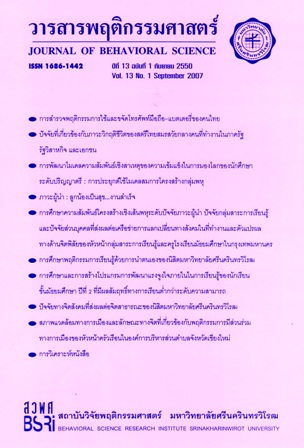การพัฒนาโมเดลความสัมพันธ์เชิงสาเหตุของความเข้มแข็งในการมองโลกของนักศึกษาระดับปริญญาตรี: การประยุกต์ใช้โมเดลสมการโครงสร้างกลุ่มพหุ (Development of A Causal Relationship Model for Sense of Coherence of Undergraduate Students: An Application of the Multiple Group Structural ..)
Abstract
The objectives of this research were to study causal relationship, develop and validate consistency with empirical data the causal relationship model of sense of coherence of undergraduate students and to test the model invariance between 2 samples: an application of the multiple group structural equation model. The model consisted of 7 latent variables; sense of coherence, social support, democratic child rearing, laissez-faire child rearing, goal setting of life, anxiety, and self-esteem; and 24 observed variables measuring those 7 latent variables. The samples consisted of 540 first year undergraduate students; 270 from Burapha University and 270 from Sripatum University Chonburi Campus. The research instrument was a five rating scale questionnaire. Data were analyzed by descriptive statistics, Pearson’s correlation coefficient analysis, confirmatory factor analysis, linear structural equation model analysis, and multiple group structural equation model analysis.
The result indicated that the adjusted model was consistent with empirical data. Model validation of a good fitted model provided χ2 = 25.869, df = 81, p = 1.000, χ2/df = 0.319, GFI = 0.996, AGFI = 0.986, RMR = 0.006, LSR = 1.635. The variables in the model accounted for 89.70 percent of the total variance of sense of coherence. The variable that had most significant effect on sense of coherence was self-esteem, democratic child rearing and anxiety, respectively. The causal relationship model of sense of coherence of undergraduate students indicated invariance of model form but the parameters were variance.
บทคัดย่อ
วัตถุประสงค์ของการวิจัยครั้งนี้เพื่อศึกษาความสัมพันธ์เชิงสาเหตุ พัฒนา และตรวจสอบ ความสอดคล้องของโมเดลความสัมพันธ์เชิงสาเหตุของความเข้มแข็งในการมองโลก ของนักศึกษาระดับปริญญาตรีกับข้อมูลเชิงประจักษ์ และทดสอบความไม่แปรเปลี่ยนของพารามิเตอร์ในโมเดลความสัมพันธ์เชิงสาเหตุของความเข้มแข็งในการมองโลกของนักศึกษาระดับปริญญาตรี โดยประยุกต์ใช้โมเดลสมการโครงสร้างกลุ่มพหุ ตัวแปร ที่ใช้ในการวิจัย ประกอบด้วยตัวแปรแฝง 7 ตัวแปร ได้แก่ ความเข้มแข็งในการมองโลก การสนับสนุนทางสังคม การอบรมเลี้ยงดูแบบประชาธิปไตย การอบรมเลี้ยงดูแบบปล่อยปละละเลย การกำหนดเป้าหมายในชีวิต ความวิตกกังวล และความภาคภูมิใจในตนเอง ตัวแปรแฝงทั้งหมดวัดจากตัวแปรสังเกตได้ 24 ตัวแปร กลุ่มตัวอย่างที่ใช้ในการวิจัย คือ นักศึกษาระดับปริญญาตรี ชั้นปีที่ 1 จำนวน 540 คน จากมหาวิทยาลัยบูรพา จำนวน 270 คน และจากมหาวิทยาลัยศรีปทุม วิทยาเขตชลบุรี จำนวน 270 คน เครื่องมือที่ใช้ในการวิจัยเป็นแบบวัดประมาณค่า 5 ระดับ วิเคราะห์ข้อมูลด้วยสถิติเชิงบรรยาย วิเคราะห์สหสัมพันธ์แบบเพียร์สันวิเคราะห์องค์ประกอบเชิงยืนยัน วิเคราะห์โมเดลสมการโครงสร้าง และวิเคราะห์โมเดลสมการโครงสร้างกลุ่มพหุ
ผลการวิจัย พบว่า โมเดลความสัมพันธ์เชิงสาเหตุของความเข้มแข็งในการมองโลกของนักศึกษาระดับปริญญาตรีมีความสอดคล้องกับข้อมูลเชิงประจักษ์ ผลการตรวจสอบความสอดคล้องมีค่า χ2 = 25.869, df = 81, p = 1.000, χ2/df = 0.319, GFI = 0.996, AGFI = 0.986, RMR = 0.006, LSR = 1.635 ตัวแปร ในโมเดลสามารถอธิบายความแปรปรวนของความเข้มแข็งในการมองโลกได้ร้อยละ 89.70 ตัวแปรที่มีอิทธิพลต่อความเข้มแข็งในการมองโลกมากที่สุด คือ ความภาคภูมิใจในตนเอง รองลงมา ได้แก่ การอบรมเลี้ยงดูแบบประชาธิปไตย และความวิตกกังวล ผลการวิเคราะห์ความไม่แปรเปลี่ยนของโมเดลความสัมพันธ์เชิงสาเหตุของความเข้มแข็งในการมองโลกของนักศึกษาระดับปริญญาตรีระหว่าง 2 กลุ่มมหาวิทยาลัยมีความไม่แปรเปลี่ยน รูปแบบของโมเดล แต่มีความแปรเปลี่ยนของค่าพารามิเตอร์
Downloads
How to Cite
Issue
Section
License
Behavioral Science Research Institute, SWU
114 Sukhumvit 23, Bangkok 10110, Thailand.
Tel.02-649-5000 # 17600


